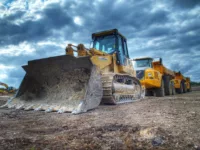You might ask what a wear plate is. The answer to that question is quite simple; they are protective separators that are used in machinery where there is a constant or intermittent rubbing of two parts creating friction. The wear plate prevents the degradation of the expensive machinery. The industries that use wear plates include mining, the military, chemical companies, steel mills, aluminum mills, and pipe mills.
What are Wear Plates Made of?
Because a wear plate is intended to wear out before the primary equipment, the material used to make the plate is often relatively soft. Most wear plates are therefore made of softer steels called “mild steel”. Wear plates can be made of different grades of steel from abrasion resistant to flame hardened to just plain hardened.
Wear plates used in the mining industry are generally made of pearlitic steel, martensentic steel, NiHard cast iron, polymers and other composite materials. The wear plate must be abrasion resistant with a thickness from 10 to 50 mm. They are quite often formed into rolled plates, but can be flat. These plates have advantages that lie in their ability to cover large areas for low costs, be cut, formed into shape, installed and replaced with relative ease. And, most importantly, they are built with a combination of hardness, fracture toughness and yield strength.
Abrasion Resistant Grades of Steel
A514 has yield strength of 100,000 psi.
AR400 is a quenched and tempered alloy of carbon, manganese and steel with high abrasion and hardness.
AR500 uses heat to harden and improve its welding and forming capabilities. It is used in mining, the truck trailer industry and making concrete/aggregate.
Wear Plates are used with These Machines
•Wear plates are used by crushers, the machines that reduce larger rocks into smaller rocks, gravel and dust.
•Industrial shredders are used to shred cars and other large metallic and non-metallic items such as coal, shingles, limestone, firebrick and asphalt. These heavy duty machines also use wear plates to protect their longevity.
•Casting Equipment – These devices mold aluminum and other metals. They are responsible for many pieces of light and heavy machinery, weapons, machine tools, parts of appliances, etc. Wear plates are essential in many casting equipment jobs.
•Steel and Aluminum Mill Equipment will roll metal and use wear plates in the production of their product.
•Heavy Earth Moving and Lining Equipment-Earth moving equipment come in many forms from crawler or wheel tractors to scrapers, loaders and bulldozers to industrial and agricultural tractors, graders and off-highway trucks and smaller equipment. Wear plates prevent the constant replacement of much more expensive equipment as these machines go about the business of lifting and hauling asphalt, soil and rock. The following are examples of earth moving equipment for which wear plates extend the life:
- Excavators
- Backhoe Loaders
- Skid Steer Loaders
- Ride-On Sweepers
- Trenchers
- Dozers
•Choppers & Scrapers both cut stones that are normally difficult to cut into smaller pieces.
•Punch Press Applications usually put holes in a material. During the course of pushing the material out to form the holes, there is an abrasive force that the wear plate protects against.
•Industrial Wood Chippers
The Design of Wear Plates
Wear plates are designed to be abrasion resistant. Therefore, as they wear they can be unbolted from your equipment and then re-ground and re-shimmed to achieve their original height. At that point, they can be re-installed in your equipment without having to replace your wear plate with another liner.
Types of Abrasion Wear
The wear plate has to be specifically designed to handle the type of wear it is being constantly exposed to the following types of abrasion exist in the mining industries:
•Low-stress Sliding Abrasion occurs in the transport of granular minerals in chutes, etc.
•High-stress Abrasion for crushing and grinding of hard rock.
•Solid Particle Erosion happens in slurry pipelines, slurry pumps and hydroclones.
•Impact Abrasion occurs in impact crushers and high-speed hammermills.
Wear Plates save millions of dollars worth of equipment each year. You can see that clearly when you consider loosing the benefit of an expensive car without the use of a wear plate. Because the wear plate forms an essential protection, the much more costly equipment stays in service for years and even decades longer.








